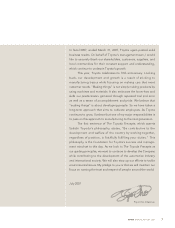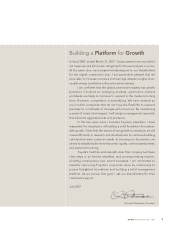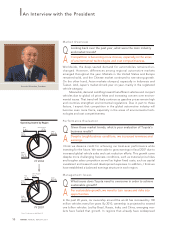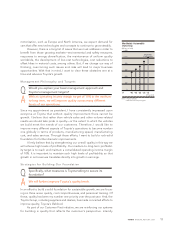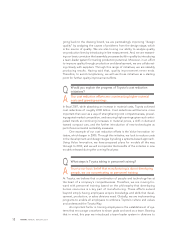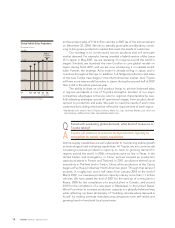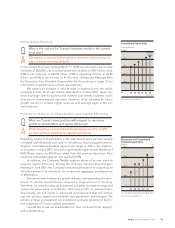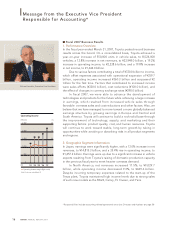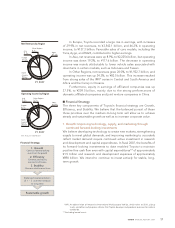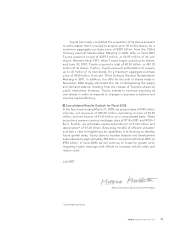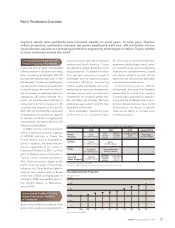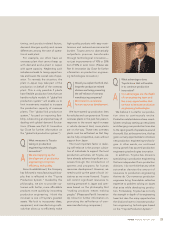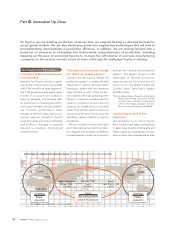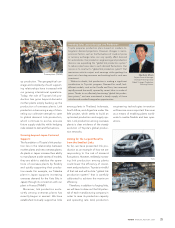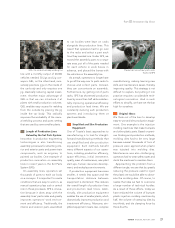Toyota 2007 Annual Report Download - page 19
Download and view the complete annual report
Please find page 19 of the 2007 Toyota annual report below. You can navigate through the pages in the report by either clicking on the pages listed below, or by using the keyword search tool below to find specific information within the annual report.
ANNUAL REPORT 2007 17
In Europe, Toyota recorded a large rise in earnings, with increases
of 29.9% in net revenues, to ¥3,542.1 billion, and 46.2% in operating
income, to ¥137.3 billion. Favorable sales of core models, including the
Yaris, Aygo, and RAV4, contributed to higher earnings.
In Asia, net revenues were up 8.9%, to ¥2,225.6 billion, but operating
income was down 19.2%, to ¥117.6 billion. The decrease in operating
income was mainly attributable to lower vehicle sales associated with
downturns in certain markets, such as Indonesia and Taiwan.
In Other Regions, net revenues grew 20.0%, to ¥1,922.7 billion, and
operating income was up 24.3%, to ¥83.5 billion. This increase resulted
from strong sales of the IMV* series in Central and South America and
Africa and the Camry in Oceania.
Furthermore, equity in earnings of affiliated companies was up
27.5%, to ¥209.5 billion, mainly due to the strong performances of
domestic affiliated companies and joint venture companies in China.
■ Financial Strategy
The three key components of Toyota’s financial strategy are Growth,
Efficiency, and Stability. We believe that the balanced pursuit of those
three priorities over the medium-to-long term will allow us to achieve
steady and sustainable growth as well as to increase corporate value.
1. Growth: Improving technology, supply, and marketing through
continued forward-looking investments
We believe developing technology to create new markets, strengthening
supply to meet global demands, and improving marketing to accurately
reflect market demand require continued active investment in research
and development and capital expenditures. In fiscal 2007, the benefits of
its forward-looking investments to date enabled Toyota to maintain
positive free cash flow even with capital expenditures** of approximately
¥1.5 trillion and research and development expenses of approximately
¥890 billion. We intend to continue to invest actively for stable, long-
term growth.
Net Revenues by Region
Europe
11.2
%
Other Regions
6.1
%
Japan
47.0
%
Asia
7.1
%
North
America
28.6
%
Europe
6.1
%
Other Regions
3.7
%
Japan
64.9
%
Asia
5.3
%
North
America
20.0
%
Operating Income by Region
FY 2007
FY 2007
Note: Fiscal year ended March 31
* IMV: An abbreviation of Innovative International Multipurpose Vehicle, which refers to SUVs, pickup
trucks, and other multipurpose vehicles that Toyota develops and produces overseas for markets
worldwide.
** Excluding leased assets
Financial Strategy
Sustainable growth
1. Growth
2. Efficiency
・Enhance profitability
and capital efficiency
3. Stability
・Maintain solid financial base
・Continue forward-looking
investment for growth
Balanced implementation
of 1. – 3. over the medium
to long term


